Scottish natural capital: ecosystem service accounts 2019
This publication, prepared by the Office of National Statistics (ONS), presents estimates of the quantity and value of ten services being supplied by Scottish natural capital.
5. Provisioning services
Food, water, and materials produced by nature and consumed by society are known as provisioning services.
Provisioning services currently included in the Scottish Ecosystem Accounts are:
- agricultural biomass
- fish caught
- timber
- water abstraction
- minerals
- oil and gas
- renewable energy
Figure 1 presents an index of the physical flows of these services.
Figure 1: Renewable energy is the fastest growing provisioning service
Index of provisioning service physical flow (2004 = 100), Scotland, 2004 to 2017
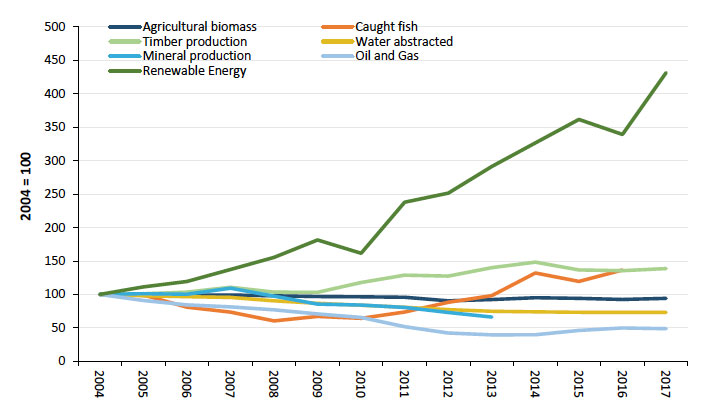
Sources: Office for National Statistics, Scottish Government, European Commission: Scientific, Technical and Economic Committee for Fisheries, Forestry Commission and Scottish Water
Figure 2 and Figure 3 show a time series of the annual valuation for the provisioning services. In 2004, oil and gas represented 92.8% of the provisioning service valuation. This decreased to 41.5% in 2015.
Figure 2: Oil and gas valuation was greater than other provisioning services combined until 2015
Annual value of oil and gas and other provisioning services, Scotland, 2004 to 2015
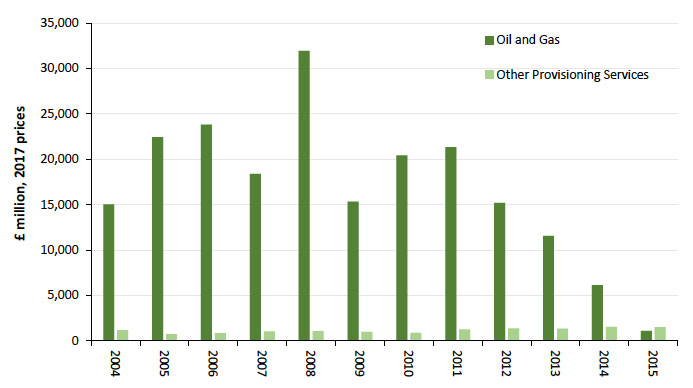
Sources: Office for National Statistics, Scottish Government, European Commission: Scientific, Technical and Economic Committee for Fisheries, Forestry Commission and Scottish Water
Figure 3: Select provisioning services (excluding oil and gas) reached time series high in 2014
Annual value of provisioning services (excluding oil and gas), Scotland, 2004 to 2015
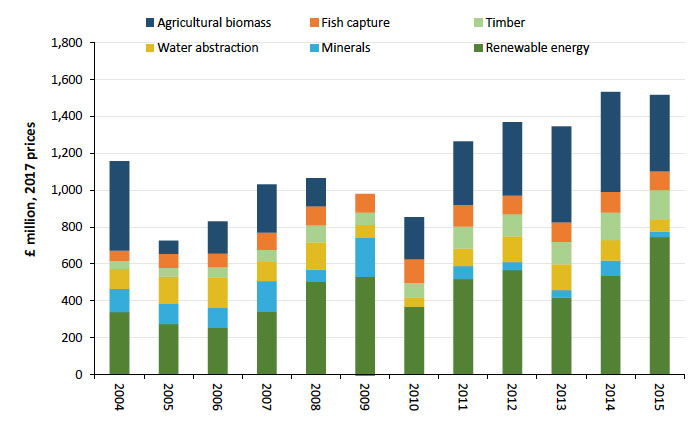
Sources: Office for National Statistics, Scottish Government, European Commission: Scientific, Technical and Economic Committee for Fisheries, Forestry Commission and Scottish Water
Note:
1. Where an annual service valuation is zero or negative it does not appear in the chart.
The total value of provisioning services in Scotland has decreased 87.8% between 2010 and 2015, compared with the value of services for the UK as a whole, which decreased 75.9% for the same period (see Figure 4).
This decrease has primarily been driven by the declining valuation of the oil and gas service, resulting from declining production, which decreased in Scotland and the UK by 94.7% and 94.6% respectively between 2010 and 2015. The decline in the valuation of oil and gas over this period can be attributed to falling income, due to production and general price decline, and increasing costs.
Figure 4: Total provisioning service valuation has declined in both Scotland and the UK
Aggregate annual value of provisioning services, United Kingdom and Scotland, 2004 to 2015
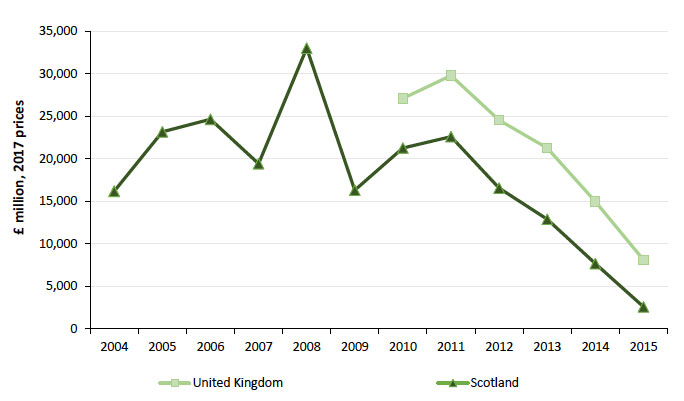
Source: Office for National Statistics
Agricultural biomass
Farmed animals are not included in these estimates as they are seen as produced rather than natural assets, instead the grass and feed that livestock eat are regarded as ecosystem services and so are included.
Agricultural biomass relates to the value of crops, fodder and grazed biomass provided to support agricultural production in Scotland. The overall volume of agricultural biomass produced in Scotland decreased from 17.20 million tonnes in 2003 to 16.32 million tonnes in 2017, equivalent to a 5.1% reduction.
This was primarily caused by a fall in the production of grazed biomass (animals consuming from the land), which dropped by 31.9% between the years 2003 and 2017. Looking at the results from the Scottish Agriculture Census, livestock in Scotland (cattle, sheep, pigs) declined over the period 2006 to 2016, which caused a fall in grazed biomass.
Agricultural biomass has generally declined year-on-year since 2003 (see Figure 5), with increases observed in 2013, 2014 and the latest year 2017. All elements of agricultural biomass rose in 2017, except for fruit and feedstock, which declined slightly.
Figure 5: In 2017, agricultural biomass production in Scotland had declined 5.1% since 2003
Agricultural biomass production in Scotland, 2003 to 2017
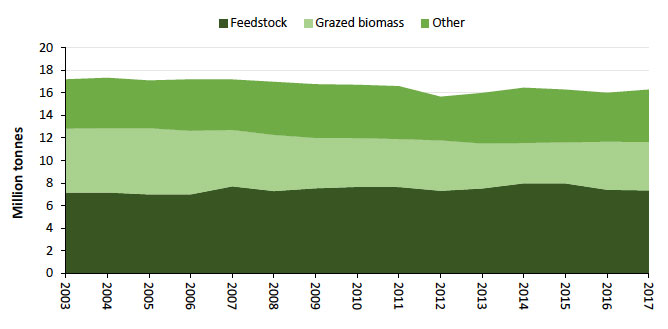
Source: Office for National Statistics and Scottish government
Note:
1. “Other” includes: Spring barley, Winter barley, Wheat, Oats, Carrots, Turnips and Swedes, Brussel sprouts, Peas, Other vegetables, Raspberries, Strawberries, Other fruit, Oilseed rape, and Potatoes.
The major two components that made up total agricultural biomass in Scotland throughout the time series were the production of feedstock (animal feed) and grazed biomass. From 2003 to 2017, the production of feedstock represented between 41% and 49% of total agricultural biomass and grazed biomass made up between 22% and 34%. The percentage of agricultural biomass in Scotland related to livestock feed (feedstock and grazed biomass combined) in 2017 was 71.3%.
The valuation of the agricultural biomass provisioning service fluctuated between 1998 and 2015, with peaks in 2004 and 2014 in line with production highs. The average valuation of agricultural biomass provisioning service over the time series was £283.8 million.
Scottish and UK agricultural biomass trends have been broadly similar, with both displaying a dip in 2012 and recent production increases during 2017. The fall in the production of agricultural biomass in 2012 may be attributed to exceptionally high rainfall.
The proportion of the UK’s agricultural biomass that is made in Scotland fluctuated between 15% and 17% between the years 2003 and 2017. Overall, the proportion has declined from 16.2% in 2003 to 15.4% in 2017. The proportion of UK feedstock grown in Scotland has declined since 1998 from a high of 37% to a low of 24% in 2017 making this one of the main drivers behind the decline in the proportion of UK agricultural biomass from Scotland.
Fish capture
In 2016, fish capture in Scottish waters was over two-thirds higher than in 2003
Fish capture in Scottish waters has increased 70% since 2003 from 628.2 thousand tonnes to 1,065.2 thousand tonnes in 2016 (see Figure 6). This is primarily due to an increase in marine fish capture, which represents the clear majority of total fish capture (over 99%). Aquaculture or farmed fish, like farmed livestock have been removed from estimates as farmed fish are viewed as a produced asset and not a natural asset.
Figure 6: Fish capture in Scottish waters rose to a record series high in 2016, driven by marine fish capture
Fish capture in Scottish waters, 2003 to 2016
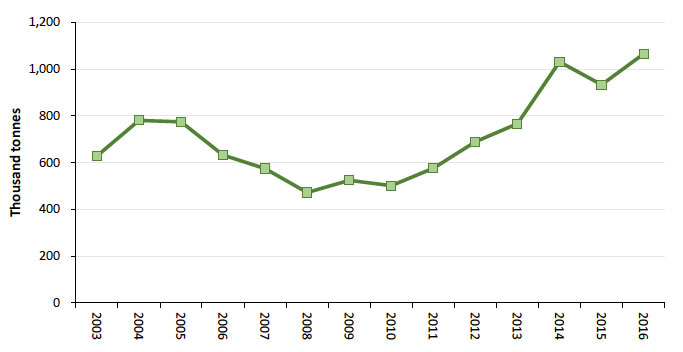
Source: European Commission: Scientific and Technical and Economic Committee for Fisheries
The largest annual increases in fish capture in Scottish waters occurred in the more recent years, with 2014 seeing an annual expansion of nearly 35% and 2016 observing an increase of 14%.
Whilst marine fish capture from Scottish vessels and landings into Scottish ports also increased in recent years it should be noted that both marine fish capture from Scottish vessels and landings into Scottish ports may not necessarily be fish captured exclusively in the Scottish exclusive economic zone (EEZ) and may come from other waters.
In 2016, of all fish caught by Scottish vessels, 84.3% (381.2 thousand tonnes) was caught in Scottish waters; this has risen from 75.7% (276.2 thousand tonnes) in 2012. Despite more Scottish vessels fishing in Scottish waters their proportional contribution to total fish capture in Scottish waters has decreased from 50.9% in 2008 to 35.9% in 2016.
Total marine fish captured in the UK EEZ followed a similar trend to those captured in Scottish EEZ between the years 2003 and 2016. This is not surprising, as fish capture in Scottish waters makes up a large proportion of all fish capture in the UK EEZ, with the proportion increasing from 60% in 2003 to 77% in 2016.
This can also be seen when comparing fishing fleets, as Scottish vessels represented around 60% of all marine fish capture from UK vessels between the years 2012 and 2016, and landings into Scottish ports made up over two-thirds of total landings into the UK.
The annual value of fish capture in Scottish waters fluctuated between the years 1998 and 2015. The annual value reached a low of £55.73 million in 2004 and a peak of £128.72 million in 2010.
Despite Scottish marine fish capture making up a large proportion of UK marine fish capture, the Scottish annual value makes up less than half of the value of UK fish capture. Looking at the UK Sea Fisheries Statistics 2017 report (PDF, 22.5MB), this may be because important elements of the Scottish fleet are engaged in several fisheries that are high volume but lower priced, such as herring and mackerel caught in the North Sea and West of Scotland waters. The Scottish fish capture provisioning service valuation should be interpreted as a minimum valuation as it excludes fish capture in Scottish waters not represented in Scottish national accounts. Please see the methodology Section 9 for further details.
Timber
Scottish timber production has almost doubled in the last 20 years
Timber production in Scotland increased 91% between 1997 and 2017, with 8.55 million cubic metres (m3) overbark standing1 of timber being removed in 2017 compared with 4.47 million m3 in 1997 (see Figure 7).
Scottish timber production has generally increased year-on-year, albeit with slight falls during the downturn in 2008 to 2009 and recently in 2015 to 2016. Despite remaining below the 2014 peak, timber production in 2017 rose to the highest level seen in three years, driven primarily by an increase in private sector production.
During the years 1997 to 2000, timber production came predominantly from the public forestry estate. However, from 2000 onwards private sector timber production was generally greater than public sector timber production and was the main factor behind the trend seen in the data since 2000. This change is primarily due to differences in the age structure and timing of timber production between woodlands on the public and private forest estates.
Figure 7: Timber production in Scotland has increased, caused primarily by a rise in private timber production
Timber production in Scotland, 1997 to 2017
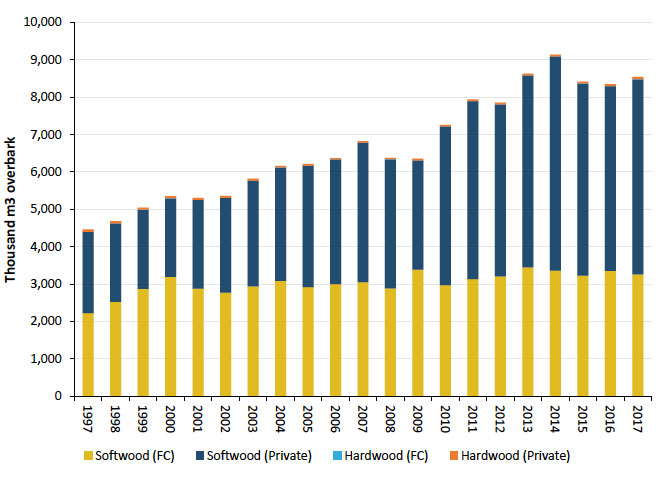
Source: Forestry Commission
Notes
1. FC stands for Forestry Commission.
2. Hardwood - broadleaved trees such as oak, birch and beech. Softwood - coniferous trees such as spruce, pine and larch.
In 2017, the value of Scottish timber production rose to £162.78 million, the highest since the series started in 1985. This was caused by increases in both stumpage prices and timber production. The stumpage price is the price paid per standing tree for the right to harvest timber from a given area.
Annual timber values generally declined year-on-year between the years 1997 to 2003 due to a steady fall in stumpage prices. In 2004, annual values rose and continued to increase until 2009, where the annual value of timber fell to £66.14 million. However, this was short-lived as the annual value of timber increased in 2010 and continued to increase until 2015 (see Figure 8).
Figure 8: The value of timber production in Scotland in 2017 rose to the highest level in the series history
Annual value of timber provision in Scotland, 1997 to 2017
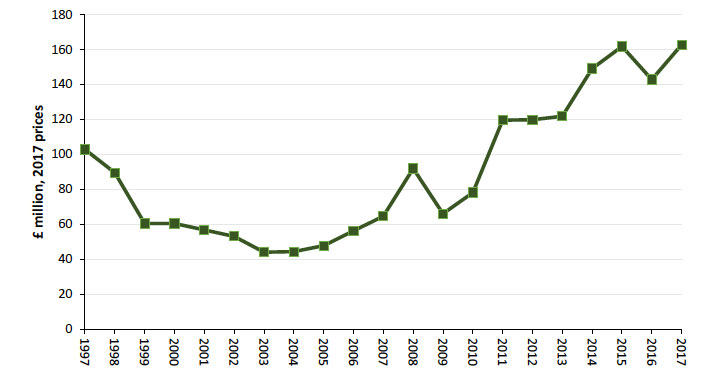
Source: Office for National Statistics and Forestry Commission
Scotland’s timber production made up 60% of the UK’s total timber production in 2017. Since 1997, the proportion of UK timber production from Scotland has generally increased year-on-year. Looking at woodland area and planting data published by the Forestry Commission this is not surprising as Scotland represents 66% of UK conifer (softwood) woodland area and the extent of Scottish woodland has been increasing at a faster rate than that of both England and Wales since 1998. According to data published in the Forest Research Forestry Statistics 2018, between the years 1998 to 2018, woodland area in Scotland has increased 11% while woodland areas in both England and Wales have expanded by only 5% and 3% respectively.
Water abstraction
Volume of Scottish water being abstracted for public water supply is falling due to less leakage
In Scotland, water abstraction (extracting water from natural sources) for public water supply by Scottish Water declined between the years 2002 and 2017, from 912 million m3 to 666 million m3 respectively (see Figure 9). This was despite both domestic consumption and operational use (fire service use, waste water treatment works, the distribution network and so on) demand increasing and was due to a reduction in the amount of water that was lost through leakages. This was reduced by nearly 50% from 413 million m3 in 2002 to 204 million m3 in 2017: meaning less water was abstracted despite the rise in demand.
Figure 9: Water abstraction in Scotland falls to its lowest level in the series history, partly caused by less leakage
Water abstraction in Scotland, 2002 to 2017
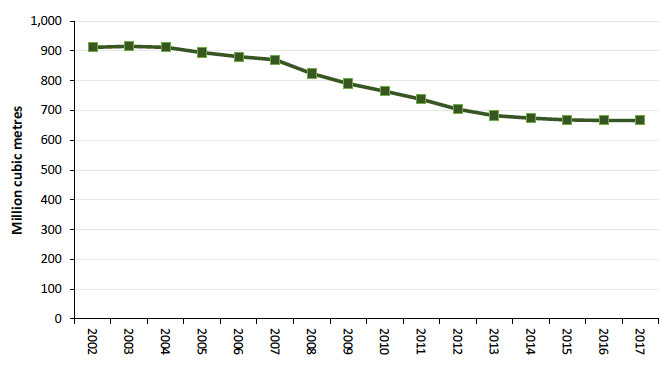
Source: Scottish Water
The value of water abstraction fluctuated throughout the time series, with a peak of £165.11 million in 2006 and a low of £63.68 million in 2016. As with the UK Ecosystem Service Accounts, the valuation of water does not include significant uses, particularly in Scotland, such as drinks manufacturing and hydroelectric power.
With a similar trend to Scotland, water abstraction for public water supply in the UK also declined over the period 2002 to 2015, albeit at a slightly slower pace. Scottish water abstraction for public water supply made up between 11% and 10% of UK water abstraction.
Minerals
Scottish minerals production declined to the lowest level in the series history during 2013
Mineral production in Scotland decreased 30.6%, from 34,599 thousand tonnes in 1997 to 24,026 thousand tonnes in 2013 (see Figure 10). Mineral production includes clay and shale, igneous rock, limestone and dolomite, sand and gravel, sandstone, barytes, fireclay, peat, silica sand, and talc.
Figure 10: Scottish mineral production in Scotland fell by nearly a third between the years 1997 to 2013
Mineral production in Scotland, 1997 to 2013
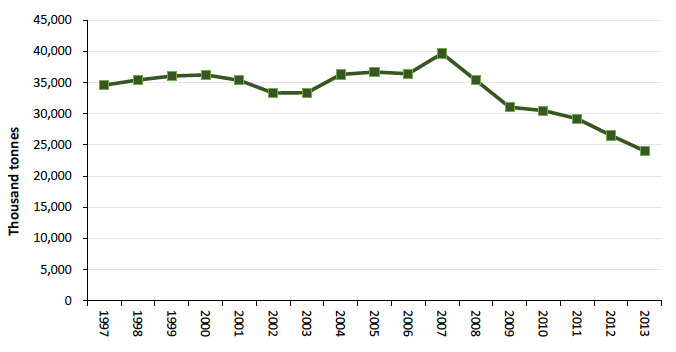
Source: British Geological Survey
Notes:
1. Data are only available up to 2013.
The decline in mineral production in Scotland can be mainly attributed to falls in the production of minerals used in the foundations for roads and buildings such as sand and gravel, and igneous rock, which declined by 50.4% and 21.3% respectively between the years 1997 to 2013.
The annual valuation of the mineral production abiotic provisioning service in Scotland has decreased, with fluctuation, by £60.2 million since 1998 (67.2%) to £29.4 million in 2015. Fluctuation has largely been driven by fluctuation in the gross operating surplus of the mining and quarrying industry in Scotland. The annual value peaked in 2009 with a valuation of £211.1 million but has since declined by 86.1% to £29.4 million in 2015. This trend is reflected in the asset valuation.
Between 1997 and 2013, a 30.6% decline in mineral production in Scotland has been a contributing factor of mineral production decline in the UK, which decreased 9.9% over the same period. In 1997, Scotland represented 15.8% (34,599.0 thousand tonnes) of UK mineral production (219,091.8 thousand tonnes). In 2013, this had decreased to 12.2% (24,026.0 thousand tonnes) of UK mineral production (197,434.7 thousand tonnes).
Unstable valuations of the mineral production abiotic provisioning service and years of negative gross operating surplus for the minerals industry in the UK National Accounts do not lend well to valuation comparisons between the UK and Scotland. Data inputs and methods will be reviewed in future accounts.
Oil and gas
Section 9 provides details on the methodology used to estimate the value of oil and gas production. This is a “resource rent” approach, which estimates the surplus remaining to the extractor after all costs and normal returns have been taken into account. This is closely related to profitability, which explains why the fall in value over recent years during a period of increasing production is significantly greater than the relative decline in the oil price and hence revenues.
Resource rent is different from an intrinsic measure of value such as the wholesale price determined by the market, which is in effect the willingness to pay for a good and therefore the value placed on it by the consumer, or the value it provides to the economy in terms of economic output (that is, gross value added). Resource rent does not value, as benefits, government receipts, employment, supply chain activity or energy security.
Oil and gas production in Scotland during 2017 has more than halved since 1998
In 2017, combined oil and gas production in Scotland was 73.7 million tonnes of oil equivalent, decreasing 58.3% from 1998 levels (176.6 million tonnes of oil equivalent). Over the time series the production of oil has decreased 83.7 million tonnes (63.2%) and gas production decreased 19.3 million tonnes of oil equivalent (43.7%). Contrasting to the long-term declining trend, since 2013, combined oil and gas production has grown 22.8%, with marginal decline between 2016 and 2017 (see Figure 11).
Between 1998 and 2017, combined production peaked in 1999 at 185.2 million tonnes of oil equivalent. Oil production reached a peak of 136.9 million tonnes in 1999 and gas production peaked at 58.8 million tonnes of oil equivalent in 2002.
Figure 11: Since 1998, oil and gas production has steadily declined, with production in 2017 less than half the amount that was produced in 1998
Oil and gas production in Scotland, 1998 to 2017
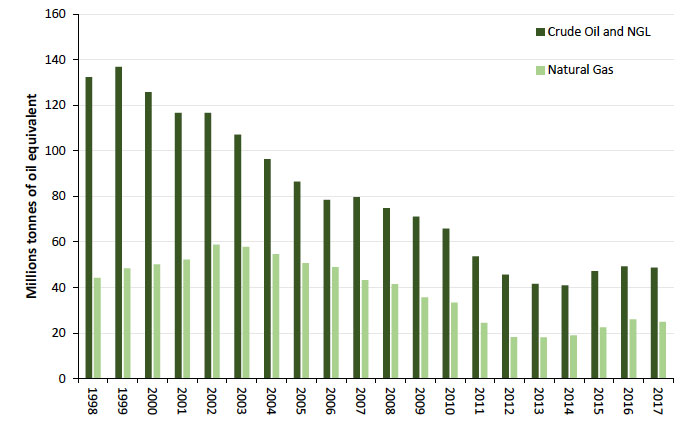
Source: Scottish Government
In 2017, Scottish combined production of oil and gas represented 81.0% of the UK overall oil and gas production. This was 6 percentage points higher than in 1998 (75.0%). This increasing proportional contribution occurs across the production of crude oil, natural gas liquid (NGL) and natural gas. In 2017, Scottish crude oil and NGL production represented 95.7% of UK production and natural gas production represented 62.3% of UK production.
The annual valuation of oil and gas abiotic provisioning in Scotland has fluctuated, driven largely by price changes and production trends (see Figure 12). The largest year-on-year real price increases were seen from 1999 to 2000 (63.5% for oil and 80.2% for gas) and 2007 to 2008 (43.3% for oil and 101.8% for gas), which saw gas prices more than double. These spikes are reflected in the annual valuation.
More recently, the annual value fell to a new series low in 2015 of £1,078.2 million despite production picking up. The fall in the annual value in 2015 was primarily due to a sharp decline in both oil and gas prices, which saw the lowest prices in 11 and 6 years respectively.
Figure 12: The valuation of oil and gas in Scotland reached a record high in 2008, due to gas prices more than doubling
Annual value of oil and gas provision, Scotland, 1998 to 2017
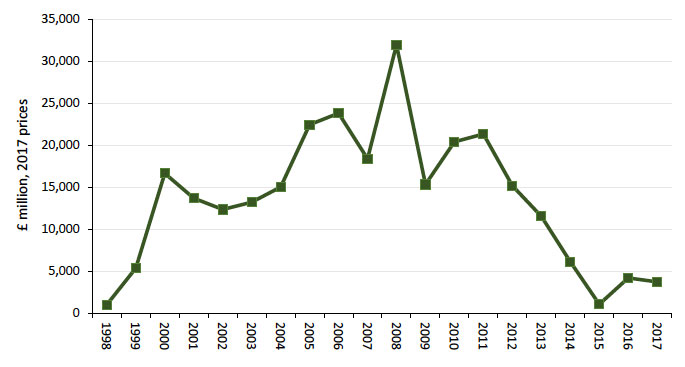
Source: Office for National Statistics and Scottish Government
The UK annual value of oil and gas followed a similar trend to Scotland, with the annual value in Scotland making up a large proportion of the UK figure. Both the Scottish and UK oil and gas calculations use the same price bases for oil and gas.
Renewable energy
In 2017, five times as much energy was produced from renewable sources in Scotland than was produced in 2000
Electricity generation from renewable sources in Scotland has increased dramatically since 2000 and by 2017 was over five times larger. National and international incentives, including the EU Renewable Energy Directive and Renewable Obligation (RO) target, have helped contribute towards the increase.
Most years have seen increases except 2003, 2010 and 2016. The 2016 decrease is attributable to a wind generation decline of 10.2%, due to a 10.9% reduction in average wind speeds. This is reflected in the wind generation load factor, a measure of generation efficiency being the utilisation of total generation capacity, which also decreased from 29.2% to 23.4% between 2015 and 2016.
The make-up of electricity generation from renewables in Scotland has changed since 2000 when hydropower represented 93.8% of production. Despite hydropower generation staying relatively stable over the time series, in 2017, it represented only 21.3% of renewable production. The relative decline of hydropower is due to generation increases in other renewables, most notably wind power, which was 78.7 times larger in 2017 compared with 2000, overtaking hydropower in 2010. Scottish wind generation peaked in 2017 (see Figure 13), representing 67.8% of the electricity generated from renewables.
Figure 13: From 2010, wind has been the largest producer of electricity from renewable sources in Scotland
Breakdown of renewable electricity generation from renewable sources, Scotland, 2000 to 2017
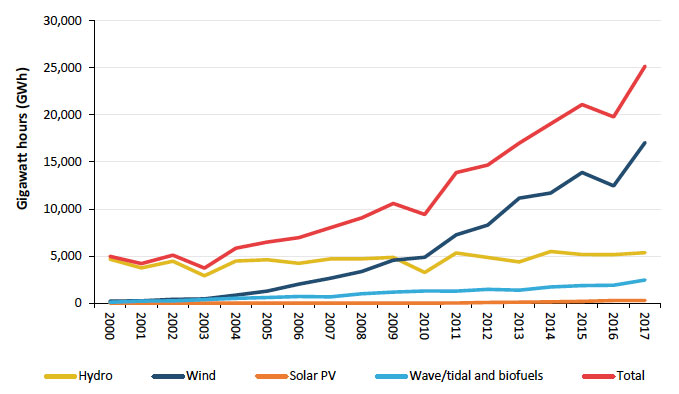
Source: Scottish Government and Department for Business, Energy and Industrial Strategy (Dukes)
Notes:
1. Wave/tidal and biofuels includes: landfill gas, sewage gas, other biofuels and wave/tidal.
2. Figures may not sum due to rounding.
In 2004, electricity generated from the renewable sector accounted for 11.7% or 5,832.2 gigawatt hours (GWh) of the total electricity generated from all sources (49,937.0 GWh) in Scotland. Whilst total generation has remained relatively stable, between 2004 and 2017, the proportional contribution of renewables has generally increased year-on-year to a high of 51.7% in 2017 or 25,165.9 GWh as shown in Figure 14.
Figure 14: In 2017, 51.7% of Scotland’s electricity production came from renewable sources
Electricity production generation from renewable and non-renewable sources, Scotland, 2004 to 2017
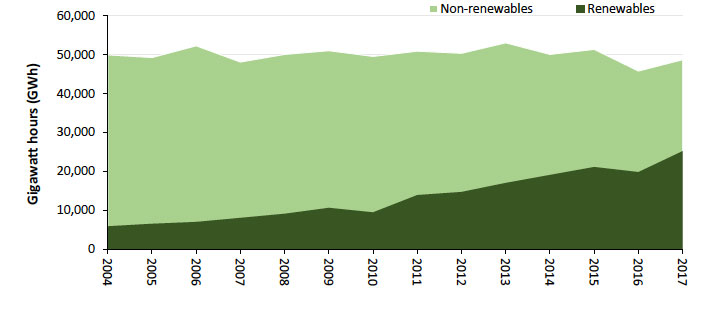
Source: Scottish Government and Department for Business, Energy and Industrial Strategy (Dukes)
Notes:
1. Non-renewables includes: coal, oil, gas, nuclear, other thermal, hydro pumped storage and non-biodegradable wastes.
2. Renewables includes: hydro, wind, wave/tidal, landfill gas, sewage gas, other biofuels and solar PV.
The monetary estimates are gross value added only and not resource rent calculations, therefore are over-estimates. The estimated gross value added of electricity generation from renewable sources in Scotland has fluctuated across the time series but overall has increased 120.5%, from £338.3 million in 2004 to a peak of £746.1 million in 2015.
In 2017, the Scottish renewable sector generated 25,165.9 GWh or 25.3% of UK renewable generation, down from 50.1% (4,971.6 GWh) in 2000. Scotland has consistently represented around 90% of UK hydropower generation. Despite Scotland’s fivefold increase in renewable electricity production its decreasing contribution to UK renewable generation is due to faster growth of renewables in England, most notably in the bioenergy sector.
Scotland’s contribution to the UK’s renewables gross value added was 64.9% in 2010 and has declined year-on-year since, to 20.3% in 2015. This declining trend follows that of the Scottish contribution to UK renewable generation.
Contact
There is a problem
Thanks for your feedback